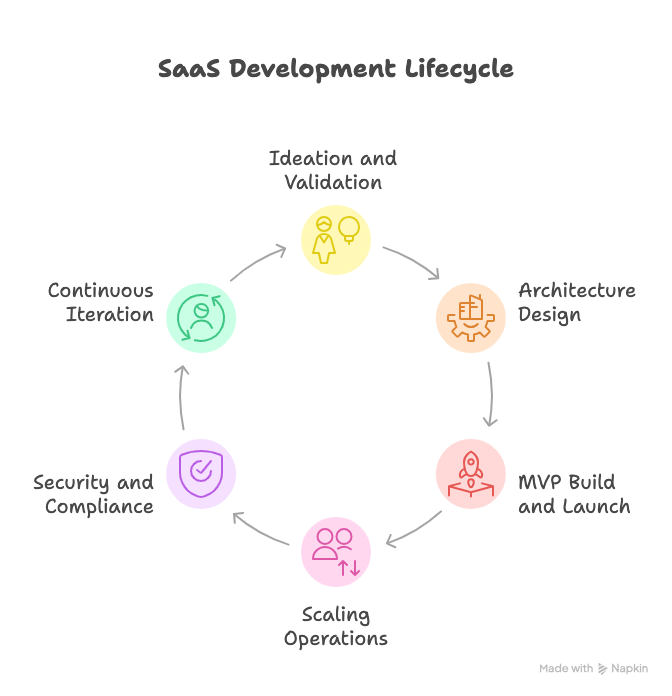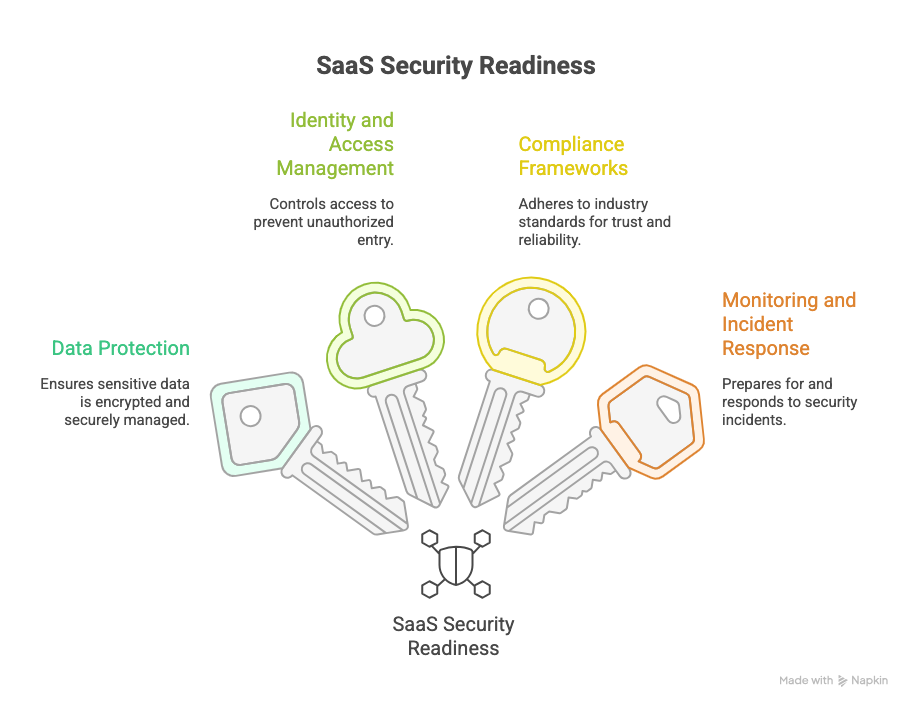SaaS Development: The Complete 2025 Guide for Founders and Product Leaders
September 29, 2025 • 12 min read

Building and scaling a SaaS product is one of the most rewarding yet challenging journeys for a founder or product leader. The market is thriving, but competition is fierce, and the difference between success and wasted investment often comes down to how well you execute the development process. SaaS development is not only about writing code or deploying infrastructure. It is about making the right tradeoffs between speed, scalability, cost, and long-term business outcomes.
This guide will walk you through every critical step of SaaS development in 2025, from architecture choices to security and compliance, from scaling infrastructure to building the right team. You will also find benchmarks, real-world lessons, and future trends that most guides miss.
Key takeaways:
- SaaS development requires balancing technical, business, and product priorities at every stage.
- Architecture decisions (monolith vs. microservices, single-tenant vs. multi-tenant) shape scalability, cost, and security.
- Compliance, security, and global deployment strategies must be designed early, not bolted on later.
- Go-to-market, pricing, and retention are as important as the technical build.
- A fractional CPO can accelerate SaaS success by aligning product vision with execution.
What is SaaS development?
SaaS development is the process of building and delivering software applications through the cloud, where customers subscribe to use the product rather than install it on their own infrastructure. Unlike traditional software models, SaaS offers scalability, continuous updates, and lower upfront costs for customers.
SaaS vs on-premise software
| Factor | SaaS | On-premise |
| Deployment | Cloud-based, accessible anywhere | Installed locally on servers |
| Costs | Subscription-based, predictable | High upfront license and infrastructure costs |
| Updates | Continuous, automatic | Manual, often infrequent |
| Scalability | Elastic, demand-based | Limited by physical resources |
| Security | Shared responsibility with vendor | Fully on customer |
The SaaS development lifecycle
Every SaaS journey follows a set of stages, though each company adapts them to its context.
- Ideation and validation: Testing your concept with real users before writing heavy code.
- Architecture and stack design: Making foundational decisions on structure, hosting, and frameworks.
- MVP build and launch: Creating the smallest product that solves the customer problem.
- Scaling operations: Handling more users, bigger data sets, and reliability expectations.
- Security and compliance: Implementing safeguards that build trust with enterprise clients.
- Continuous iteration: Regularly refining based on customer feedback and product-market fit.

SaaS architecture and technical foundations
The architecture you choose at the start will shape how fast you can move, how well you scale, and how costly your operations become. Founders often face a dilemma between moving quickly with a simple monolithic application or investing upfront in a microservices-based approach.
- Monolithic applications are easier to build and deploy, making them ideal for MVPs. But as the product grows, they can become rigid and harder to scale independently.
- Microservices architectures separate functions into modular services, which improves flexibility and scaling but adds complexity in orchestration and monitoring.
On top of this, there is the multi-tenant vs single-tenant debate. Multi-tenant architectures allow multiple customers to share the same infrastructure, reducing costs and easing updates. Single-tenant architectures, while more expensive, give customers their own isolated environment, often necessary for enterprise clients with strict compliance requirements.
Finally, cloud-native and serverless patterns are gaining traction. By using managed services and function-based execution, teams can reduce operational overhead and focus on delivering customer value. A hybrid approach, starting with a monolith and gradually modularizing into microservices, is often the most pragmatic path for SaaS startups.
Operational excellence and scalability
A SaaS product that fails during peak demand quickly loses customer trust. Operational excellence means building systems that not only handle traffic growth but also recover gracefully from failures.
- Observability is the foundation. Teams need dashboards that combine logs, metrics, and traces into a single picture of system health. Without visibility, every outage becomes a guessing game.
- Scalability strategies go beyond autoscaling servers. Effective caching layers, database sharding, and message queues all help balance load. For example, caching frequently requested data at the edge can drastically reduce latency.
- Reliability practices such as setting SLAs and SLOs, running game-day simulations, and conducting postmortems create a culture of resilience.
Companies like Netflix and Amazon are famous for investing heavily in chaos testing, deliberately breaking their systems to ensure they can survive real failures. Even smaller SaaS businesses can borrow this mindset by simulating outages in staging environments. Scalability is not only about infrastructure; it is about designing systems that degrade gracefully and keep customers productive even when parts of the system misbehave.
SaaS security and compliance essentials
Trust is the foundation of every SaaS business, and nothing erodes it faster than a security breach. Security cannot be an afterthought added before launch, it must be woven into the architecture from day one.
- Data protection: All sensitive data should be encrypted at rest and in transit, with strong key management practices.
- Identity and access management: Role-based access controls, single sign-on, and audit trails reduce the risk of unauthorized access.
- Compliance frameworks: SOC2, ISO 27001, and GDPR are not just boxes to tick. They signal maturity to enterprise buyers. HIPAA is a requirement if you operate in healthcare, while PCI DSS applies if you handle payments directly.
- Monitoring and incident response: Regular penetration testing, bug bounty programs, and clear escalation paths prepare teams for the inevitable.
Security and compliance may feel like slowing down product velocity, but in practice, they accelerate growth by removing barriers in enterprise sales cycles and boosting customer confidence.

Cost optimization and cloud economics
The flexibility of the cloud can be both a blessing and a curse. Many SaaS startups wake up to spiraling AWS or Azure bills because they scaled faster than they optimized. To avoid this, founders need to master the core levers of cloud cost management that keep expenses under control while supporting growth. These include:
- Rightsizing and autoscaling: Continuously adjust compute resources to match demand. Overprovisioning may feel safe, but it burns capital unnecessarily.
- Spot and reserved instances: Using a mix of discounted compute options can cut costs by up to 70 percent if workloads are predictable.
- Monitoring costs by feature: Tagging infrastructure resources lets you see which features drive the biggest infrastructure spend. This data can shape pricing models and identify features that may not justify their costs.
- Data lifecycle management: Storing old logs or user data indefinitely becomes costly. Implementing retention policies and archiving cold data saves money.
Founders should treat cloud economics as a product decision, not just an engineering one. Cost optimization strategies directly affect margins and determine whether growth translates into profitability.
Going global: multi-region and localization
Global expansion is both a growth opportunity and a technical challenge. Customers expect fast, reliable experiences wherever they are located, and regulations add complexity. To build a SaaS product that scales across borders, leaders must address:
- Latency and performance: Deploying in multiple regions reduces lag for customers far from your primary servers. Content delivery networks (CDNs) and edge computing bring resources closer to users.
- Data residency laws: Regulations like GDPR or China’s Cybersecurity Law require specific handling of personal data. Storing customer data in the correct jurisdiction is non-negotiable for compliance.
- Localization: Going global is not just about translating text. It includes supporting local payment methods, currencies, time zones, and cultural nuances.
Companies that plan global infrastructure from the start avoid painful migrations later. A SaaS that loads instantly and feels tailored to the local market has a natural advantage over competitors.
Team structure and organizational models for SaaS development
Behind every successful SaaS product is a team that knows how to collaborate effectively. Team structure evolves as the company matures, and leaders should plan for shifts in responsibility as complexity grows. At a high level, the organizational journey looks like this:
- Early-stage startups usually rely on small, generalist teams where engineers wear multiple hats. The focus is on shipping fast and validating product-market fit.
- Growth-stage companies start to specialize. DevOps engineers handle infrastructure, QA specialists ensure quality, and product managers align roadmaps with customer needs.
- Scaling companies often introduce platform teams and site reliability engineers. They create reusable tools and practices that other squads can leverage.
An important cultural shift is adopting a “you build it, you run it” mindset. Teams that own both development and operations feel accountable for reliability and customer impact. This avoids finger-pointing and speeds up issue resolution.
Go-to-Market, pricing, and retention
Even the best-built SaaS fails without a clear go-to-market plan. Development and business strategy must move in sync. The most impactful levers to consider are:
- Pricing models: Freemium drives volume but risks low conversion. Tiered pricing simplifies choices but may leave revenue on the table. Usage-based pricing aligns costs with value and is increasingly favored by modern SaaS businesses.
- Onboarding experience: A poor first impression leads to churn before customers even see value. Guided tours, in-app messaging, and fast time-to-value make onboarding smoother.
- Retention strategies: Customer success teams, proactive support, and data-driven insights reduce churn. Tracking metrics like net revenue retention (NRR) and customer lifetime value (LTV) ensures long-term sustainability.
Pricing and retention are product levers just as much as engineering decisions. Teams that treat them as core to development see stronger returns on their efforts.
SaaS pricing models comparison
| Pricing model | Pros | Cons |
| Freemium | – Low barrier to entry attracts large user base – Great for viral growth and brand awareness | – High infrastructure costs for free users – Conversion to paid plans can be low |
| Tiered (Basic, Pro, Enterprise) | – Simple to understand – Appeals to different customer segments – Predictable recurring revenue | – Risk of customers being “stuck” between tiers – Can be hard to price features fairly across tiers |
| Usage-Based (Pay-as-you-go) | – Aligns costs with actual usage – Attractive to cost-sensitive or scaling businesses – Potential for high revenue from heavy users | – Revenue can be unpredictable – Customers may limit usage to control costs |
| Flat-Rate | – Easy to sell and explain – Predictable revenue per customer | – May undercharge heavy users or overcharge light users – Limited flexibility for different customer needs |
| Per-User / Seat-Based | – Easy to calculate and scale with team size – Clear value alignment for collaboration tools | – Discourages adoption across entire organizations – Customers may share accounts to reduce costs |
Case study: How Slack’s product-led strategy built an empire
A while ago, I dove deep into Slack’s growth story and discovered that it perfectly illustrates the power of a Product-Led Growth (PLG) strategy. Slack didn’t just build a great product; they turned the product itself into their main marketing and sales engine. Instead of pushing for sales, they focused on removing all friction for the user through a brilliant Freemium model, which allowed them to grow organically from small teams into entire enterprises.
This approach, where value comes before payment, isn’t just an isolated success story but a trend backed by solid data. Recent report from High Alpha shows that PLG companies are valued at double the public SaaS market average, with some enjoying gross margins that are up to 10 percentage points higher.
Furthermore, this model directly addresses how customers prefer to buy today; nearly 75% of B2B buyers prefer to try a product on their own before speaking with a sales representative. Ultimately, Slack’s success, built on a deep understanding of user behavior and data (like their “magic number” of 2,000 messages) is living proof that a product-centric strategy doesn’t just work; it’s the most effective way to build a sustainable and thriving SaaS business, a fact also confirmed by data from Paddle showing higher conversion rates in such models.
Migration, versioning, and upgrades
SaaS customers expect continuous improvement without disruption. Managing updates is a balancing act between shipping new features and maintaining stability. The most reliable approaches are:
- Deployment strategies: Blue/green deployments allow you to switch traffic between old and new environments with minimal downtime. Canary releases gradually roll out features to a subset of users, reducing risk.
- API versioning: Breaking APIs without notice erodes trust. Teams should support multiple versions during transitions and provide clear migration guides.
- Database migrations: Schema changes should be backward-compatible, with rollbacks planned. Feature flags allow teams to toggle new functionality safely.
The companies that excel here are the ones customers barely notice updating, they deliver constant value without disruption.
Future of SaaS development: Trends to watch in 2025 and beyond
SaaS continues to evolve rapidly, and founders who anticipate trends stay ahead of the curve. In 2025 and beyond, the most influential shifts are:
- AI-native SaaS: Rather than adding AI features as an afterthought, new products are being built with machine learning at their core. These platforms adapt to user behavior in real time.
- Serverless-first architectures: Function-based services reduce infrastructure management, letting teams focus solely on business logic.
- Edge computing and WebAssembly: Pushing computation closer to users improves speed and creates opportunities for low-latency applications like real-time analytics.
- Low-code and no-code extensibility: Giving customers the ability to customize workflows without writing code increases stickiness and reduces churn.
- Usage-based billing: Customers prefer paying for what they use, creating a fairer alignment of costs and delivered value.
By staying aware of these shifts, SaaS leaders can make forward-looking investments and ensure their platforms remain competitive as the industry evolves.
How a fractional CPO can accelerate SaaS development
Technical execution often falters when the product vision is unclear. Without strong product leadership, teams risk chasing features that do not matter, scaling prematurely, or overlooking retention.
A fractional CPO brings senior-level product expertise without the cost of a full-time executive. They help align engineering with strategy, prioritize roadmaps, and ensure development translates into business growth.
If you are building or scaling a SaaS product and want to avoid costly mistakes, explore our fractional CPO services to bring clarity and execution power to your journey.
Conclusion
SaaS development is both a technical and strategic challenge. The best teams succeed by balancing architecture, operations, compliance, and product-market fit. By following the lifecycle, anticipating risks, and embracing modern practices, you can build a SaaS that not only works but thrives.
And with the right leadership, such as a fractional CPO guiding your roadmap, your chances of scaling successfully increase dramatically.
FAQ’s
What is SaaS development?
SaaS development is the process of building, deploying, and maintaining cloud-based software that customers access through the internet on a subscription basis.
How long does it take to develop a SaaS product?
It depends on complexity and team size. A simple MVP can take 3–6 months, while enterprise-grade SaaS platforms may require 12–18 months or more.
What is the cost of SaaS development?
Costs vary widely. Building an MVP may range from $50,000 to $200,000 depending on scope and location of the development team. Ongoing costs include infrastructure, security, and customer support.
What are the biggest challenges in SaaS development?
The most common challenges are scalability, maintaining security and compliance, managing cloud costs, and aligning product features with market demand.
What is the SaaS development lifecycle?
It typically includes ideation, architecture design, MVP build, scaling infrastructure, adding security and compliance, and continuous improvement.

Sivan Kadosh is a veteran Chief Product Officer (CPO) and CEO with a distinguished 18-year career in the tech industry. His expertise lies in driving product strategy from vision to execution, having launched multiple industry-disrupting SaaS platforms that have generated hundreds of millions in revenue. Complementing his product leadership, Sivan’s experience as a CEO involved leading companies of up to 300 employees, navigating post-acquisition transitions, and consistently achieving key business goals. He now shares his dual expertise in product and business leadership to help SaaS companies scale effectively.